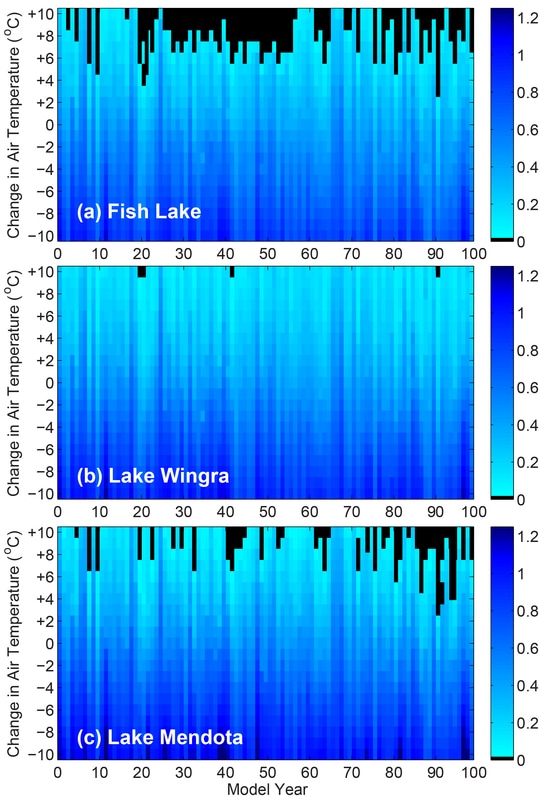Global lake ice loss
Ice provides a range of ecosystem services—including fish harvest, cultural traditions, transportation, recreation, and regulation of the hydrological cycle—to more than half of the world’s 117 million lakes. One of the earliest observed impacts of climatic warming has been the loss of freshwater ice, with corresponding climatic and ecological consequences. In a collaborative project led by Sapna Sharma, using observations from 513 lakes around the Northern Hemisphere, we identify lakes vulnerable to ice-free winters. Our analyses reveal the importance of air temperature, lake depth, elevation and shoreline complexity in governing ice cover. We estimate that 14,800 lakes currently experience intermittent winter ice cover, increasing to 35,300 and 230,400 at 2 and 8 °C, respectively, and impacting up to 394 and 656 million people.
Ice provides a range of ecosystem services—including fish harvest, cultural traditions, transportation, recreation, and regulation of the hydrological cycle—to more than half of the world’s 117 million lakes. One of the earliest observed impacts of climatic warming has been the loss of freshwater ice, with corresponding climatic and ecological consequences. In a collaborative project led by Sapna Sharma, using observations from 513 lakes around the Northern Hemisphere, we identify lakes vulnerable to ice-free winters. Our analyses reveal the importance of air temperature, lake depth, elevation and shoreline complexity in governing ice cover. We estimate that 14,800 lakes currently experience intermittent winter ice cover, increasing to 35,300 and 230,400 at 2 and 8 °C, respectively, and impacting up to 394 and 656 million people.
Abrupt changes of ice cover and temperature in Lake Mendota
Abrupt shifts, rather than linear changes, can occur in both climate and lake variables over long timescales; however, the assumption that lakes can undergo monotonic changes over time can hide underlying mechanisms that are responsible for those changes. In Madison, WI, air temperature increased at the rate of 0.081°C per decade from 1911-1980, but that increase was 0.334°C per decade from 1981-2014. Average annual wind speed at 4.44 meters per second until 1994, after which a significant shift occurred to 3.74 meters per second. These climate shifts split the historical climate into three distinct periods: 1911-1981, 1981-1994, 1994-2014. We found differences in ice cover variables (ice on dates, ice duration, maximum ice thickness, under-ice water temperatures, and freeze-over water temperatures) and open water variables (stratification onset date, midsummer epilimnetic temperature, midsummer hypolimnetic temperature, epi-hypo temperature difference, hypolimnetic heating, turnover date, and stratification duration) that correspond to these three distinct periods. This research was supported by the NTL-LTER and University of Wisconsin Water Resources Institute.
Abrupt shifts, rather than linear changes, can occur in both climate and lake variables over long timescales; however, the assumption that lakes can undergo monotonic changes over time can hide underlying mechanisms that are responsible for those changes. In Madison, WI, air temperature increased at the rate of 0.081°C per decade from 1911-1980, but that increase was 0.334°C per decade from 1981-2014. Average annual wind speed at 4.44 meters per second until 1994, after which a significant shift occurred to 3.74 meters per second. These climate shifts split the historical climate into three distinct periods: 1911-1981, 1981-1994, 1994-2014. We found differences in ice cover variables (ice on dates, ice duration, maximum ice thickness, under-ice water temperatures, and freeze-over water temperatures) and open water variables (stratification onset date, midsummer epilimnetic temperature, midsummer hypolimnetic temperature, epi-hypo temperature difference, hypolimnetic heating, turnover date, and stratification duration) that correspond to these three distinct periods. This research was supported by the NTL-LTER and University of Wisconsin Water Resources Institute.
Check out this awesome data visualization of our model results by Hilary Dugan!
Magee, M.R., Wu, C.H., Robertson, D.M., Lathrop, R.C., and Hamilton, D.P. 2016. Trends and regime shifts in 100-year ice cover and water temperatures in a dimictic lake in response to changes in air temperature, wind speed, and water clarity. Hydrology and Earth Systems Sciences, 20, 1681-1702. doi:10.5194/hess-20-1681-2016
|
Role of lake morphometry on the effects of changing climate to ice cover and lake thermal structure
Lake morphometry (i.e. lake depth and surface area) plays a significant role in affecting physical processes like wind mixing, water circulation, and heat storage, which can in turn influence both ice cover and thermal structure. This research investigated the role of lake morphometry in long term changes, variability, and sensitivity of lake ice cover and water temperatures to increasing air temperature and decreasing wind speeds. Ice cover period has decreased due to later ice-on dates and earlier ice-off dates, and the annual maximum ice cover thickness has decreased for the three study lakes during the last century. We found that overall, shallower lakes with larger surface areas appear more resilient to ice cover changes caused by climate changes. For open water variables, lake depth impacts the presence of stratification and magnitude of Schmidt stability, while lake surface area drives differences in hypolimnion temperature, hypolimnetic heating, variability of Schmidt stability, and stratification onset and fall overturn dates. This research was supported by the NTL-LTER and University of Wisconsin Water Resources Institute. |

